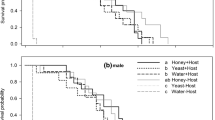Abstract
A kairomone from adultHeliothis zea (Boddie) scales is an important factor in the host selection process ofTrichogrammapretiosum Riley. If the host density is sufficiently high (i.e., 1 egg/500 cm2) and higher), a complete coverage or solid treatment of kairomone spray may be the optimum for increasing parasitization rates, but this is not the case at lower host densities (e.g., 1 egg/2000 cm2). At the lower densities, the kairomone must be distributed in such a way as to retain the parasitoids in the target area without inhibiting their movement from one ovi-position site to the next. Simulated moth scale particles appear to fill this need since their density can be regulated to provide the optimum frequency of parasitoid stimulation and thus maximum rates of parasitization at prevailing host densities.
Similar content being viewed by others
References
Burton, R.L. 1969. Mass rearing the corn earworm in the laboratory, USDA-ARS 33-134.
Jones, R.L., Lewis, W.J., Beroza, M., Bierl, B.A., andSparks, A.N. 1973. Host-seeking stimulants (kairomones) for the egg parasite,Trichogramma evanescens.Environ. Entomol. 2:593–596.
Lewis, W.J., andRedlinger, L.M. 1969. Suitability of the almond moth,Cadra cautella, of various ages for parasitism byTrichogramma evanescens.Ann. Entomol. Soc. Am. 62:1482–1484.
Lewis, W.J., Sparks, A.N., andRedlinger, L.M. 1971. Moth odor: A method of host-finding byTrichogramma evanescens.J. Econ. Entomol. 64:557–558.
Lewis, W.J., Jones, R.L., andSparks, A.N. 1972. A host-seeking stimulant for the egg parasite,Trichogramma evanescens: Its source and a demonstration of its laboratory and field activity.Ann. Entomol. Soc. Am. 65:1087–1089.
Lewis, W.J., Jones, R.L., Nordlund, D.A., andSparks, A.N. 1975a. Kairomones and their use for management of entomophagous insects: I. Evaluation for increasing rate of parasitization byTrichogramma spp. in the field.J. Chem. Ecol. 1:343–347.
Lewis, W.J., Jones, R.L., Nordlund, D.A., andGross, H.R., Jr. 1975b. Kairomones and their use for management of entomophagous insects: II. Mechanisms causing increase in rate of parasitization byTrichogramma spp.J. Chem. Ecol. 1:349–360.
Nordlund, D.A., Lewis, W.J., Gross, H.R., Jr., andHarrell, E.A. 1974. Description and evaluation of a method for field application ofHeliothis eggs and kairomones forTrichogramma.Environ. Entomol. 3:981–984.
Oatman, E.R., Platner, G.R., andGonzalez, D. 1970. Reproductive differentiation ofTrichogramma pretiosum, T. semifumatum, T. minutum, andT. evanescens with notes on the geographic distribution ofT. pretiosum in the southwestern United States and Mexico (Hymenoptera: Trichogrammatidae).Ann. Entomol. Soc. Am. 63:633–635.
Author information
Authors and Affiliations
Additional information
Hymenoptera: Trichogrammatidae.
In cooperation with the University of Georgia College of Agriculture Experiment Stations, Coastal Plain Station, Tifton, Georgia 31794. Accepted for publication November 21, 1978.
Mention of a commercial or proprietary product in this paper does not constitute endorsement by the USDA.
Rights and permissions
About this article
Cite this article
Lewis, W.J., Beevers, M., Nordlund, D.A. et al. Kairomones and their use for management of entomophagous insects. J Chem Ecol 5, 673–680 (1979). https://doi.org/10.1007/BF00986552
Received:
Revised:
Issue Date:
DOI: https://doi.org/10.1007/BF00986552




